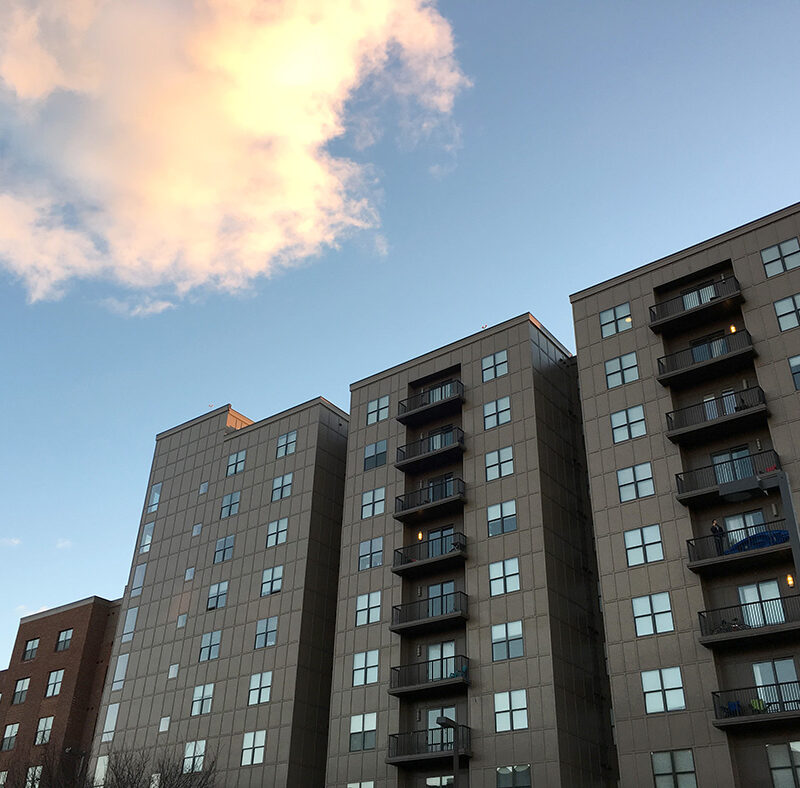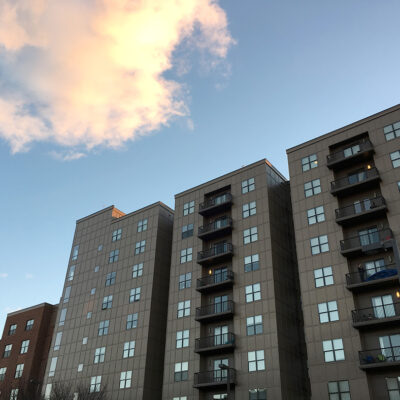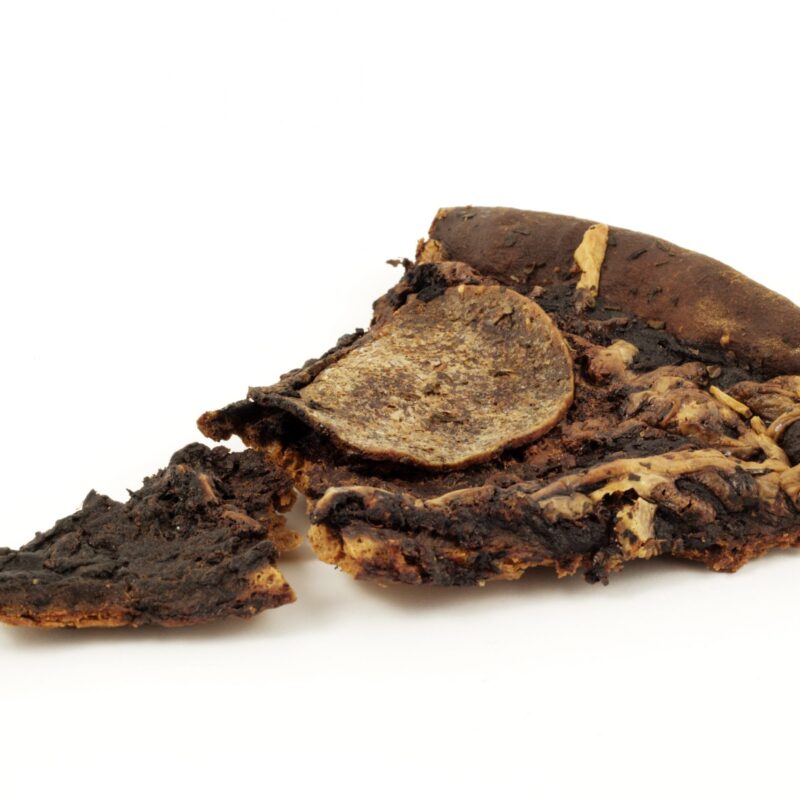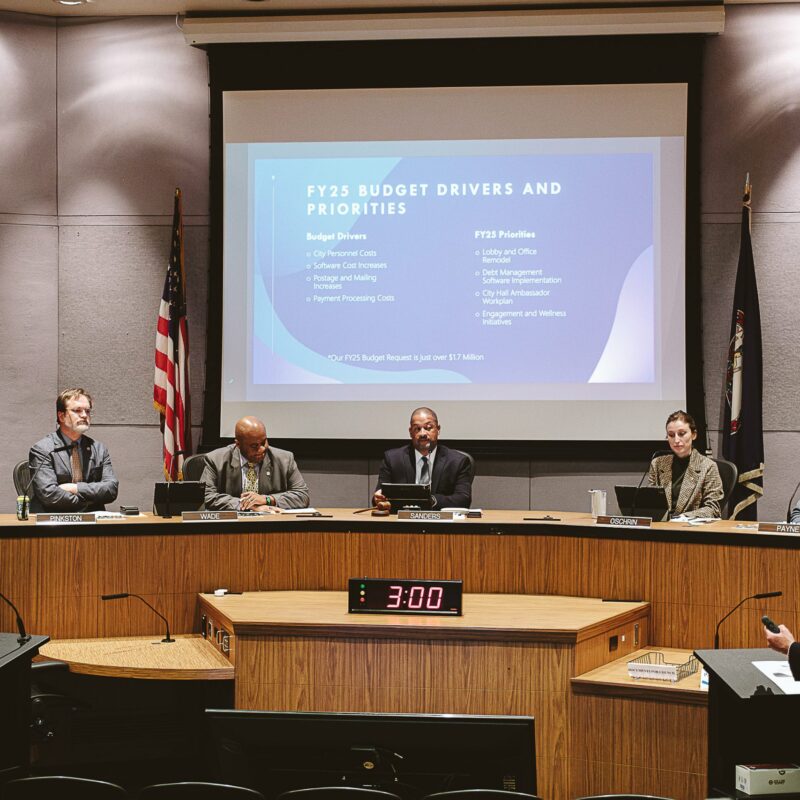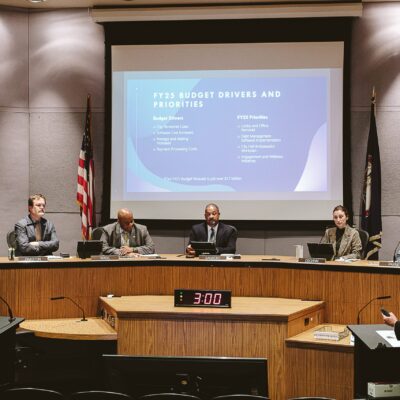It’s not yet 1pm, but Steve is closing in on his $30 panhandling goal. His feet bracket a black duffel bag and a blue Maxwell House coffee container with a few bills inside. He doesn’t ask for money aloud, so a potential donor must get close enough to read his sign:
“Due to the economy, I find myself unemployed and homeless and hungry, and health is bad. Any help you can give would be greatly appreciated.”
His goal, Steve says, depends on the day. He could aim for $60, and get it, but it might take him until 10pm or later. Once, in a nearly 18-hour stretch, he received $185—some $10s, some $20s. Last fall, he and a friend were seated by The Paramount when a man gave each a $100 bill.
“Do you know a local book author named John Grisham?” he asks. (According to Steve, Grisham advised the two to put the bills in a safe place and “have a nice Thanksgiving.”)
Steve is sitting in front of the Jefferson Theater—close enough to the theater that he could be part of the façade, far enough from a nearby restaurant patio to be within his rights as a panhandler. Recently, he tells a reporter, City Hall has been talking about the issue of “aggressive panhandling” on the Downtown Mall.
“I’m not being aggressive to anybody,” he says. When it comes to giving money, “I let you decide.” He also knows the portion of the City Code pertaining to aggressive panhandling: “Where I’m sitting right now, cops won’t bother me.”
Steve isn’t the only one thinking about the code’s provisions. On July 1, Acting City Manager Maurice Jones sent a round of know-your-rights letters to Downtown business owners in response to rising concerns about panhandling.
“We continue to research all legal options to assertively address lingering concerns while being mindful of the constitutional rights of those on the Mall,” reads the letter. It adds that city staff “will be approaching Council in the very near future with a request to amend the code once again to deal with the increase of aggressive panhandlers and disturbances.”
For some, the “increase” may be a matter of opinion. During 13 years as owner of the Blue Ridge Country Store, Dan Pribus says an occasional person entered the store and asked for coffee or cash, and “they were kindly asked to leave.” But Pribus says he hasn’t had problems with panhandlers lately.
Neither has Dan Pabst, director of operations for Mudhouse coffee shop at the other end of the Mall. Pabst says he’s noticed more panhandlers this year, but received fewer complaints from customers.
|
Tony LaBua, owner of Chaps, says that panhandling problems on the Downtown Mall have grown worse since the Haven homeless shelter opened Downtown. “You know, we’re watching guys and women on the Mall who are quite capable of working, going out and getting a job,” he says. “But they choose panhandling instead.” |
Yet while some local comments and data suggest an “increase” may not be as severe as the memo makes it sound, a few business owners think they can pinpoint a culprit in the reported rise in panhandling.
“We’ve finally got the Mall to a point where people are coming Downtown—we’ve made it the entertainment center of Charlottesville, and it’s all good and it’s been flourishing, absolutely flourishing,” says Tony LaBua, the owner of Chaps, a Downtown restaurant for more than 20 years. “And somebody comes along and decides to put a homeless shelter smack in the middle of it.”
LaBua says the panhandlers are coming from The Haven, the Downtown homeless day shelter located in the First Street Church on Market Street that was funded by Hollywood director Tom Shadyac and opened in January. And while city officials tackle panhandling issues anew, others are left wondering whether a surge in panhandling complaints signifies a greater homelessness problem.
The cost of doing business
“We have been here now for two-and-a-half years, and there has been quite an increase in panhandlers, especially in the past year,” says George Benford, owner of Siips Wine and Champagne Bar, located a couple of doors down from the unfinished Landmark Hotel and on the same block as Chaps.
“It’s definitely a problem, without a doubt,” says Benford. “And it’s to the point that I think all of the café owners and a lot of businesses are ready to get together and really do something about it.”
LaBua, who says Chaps has not been directly affected yet by aggressive panhandlers, agrees.
“How has it affected me? It really hasn’t, and I don’t want it to,” says LaBua. “And that’s why I think we need to come forward now and to stop it.”
Robert Stroh, co-chair of the Downtown Business Association of Charlottesville (DBAC), refers to panhandling as “one of those things that we believe is inappropriate use of people’s free speech right on our Downtown Mall.
“It makes people uncomfortable, or they feel intimidated, and they don’t know what to do about it,” says Stroh.
|
Mayor Dave Norris says the city cannot outlaw panhandling, which is a constitutionally protected right. “But we can regulate and restrict panhandling,” he says—potentially beyond the city code’s current provisions. |
Mayor Dave Norris— former director of People and Congregations Engaged in Ministry (PACEM), which operates a seasonal nighttime shelter—says he has not personally noticed an increase. However, he says the city sees a rise in complaints each summer about homeless and panhandlers on the Mall.
“One of the reasons why we sent out the memo was to make it clear what laws were already on the books about regulating panhandling,” says Norris. “Because we get questions or complaints from business owners about things that are already illegal.”
Those regulations forbid panhandlers from collecting cash on public transportation, within 15′ of bank entrances and ATMs, and “from any person seated within an outdoor café area” during hours of operation. “Aggressive panhandling” is largely defined by the reaction of the person solicited—whether he feels he was intentionally touched, pursued in an intimidating manner or were the recipient of obscene gestures or language.
Follow the code, however, and a panhandler is within his rights to collect on the Mall. However, while Charlottesville is on pace to notch its highest number of aggressive panhandling citations in the last three years, numbers suggest the scene Downtown may be less “aggressive” than some business owners think.
In 2008, the city issued four citations for aggressive panhandling, and only one in 2009. This year, Charlottesville Police have issued four citations as of July 13. However, not a single citation issued in the past three years was given on the Downtown Mall. Lieutenant Gary Pleasants of the Charlottesville Police Department (CPD) says a “vast majority” of complaints about panhandling lead police to individuals who are in fact not acting outside the city code.
So, with no citations doled out Downtown, is aggressive panhandling the issue that a few local business owners make it out to be? Or is a surge in complaints a way of policing an idealized vision of the Downtown Mall?
While there is no official measure of the panhandling population, there is a documented increase in the number of homeless in the Charlottesville area in the last year. And for some business owners, that’s enough to wonder whether the Haven is creating one problem while trying to address another.
Spare some quarters?
The Thomas Jefferson Area Coalition for the Homeless (TJACH) conducts its annual “Point-In-Time” (PIT) census for the area homeless population in January. The U.S. Department of Housing and Urban Development requires that the census take place in January, which yields a “higher number of homeless individuals that are sheltered than is true for half the year,” according to the report. PACEM’s shelter, for instance, closes its doors from April to October, eliminating 70 of the 177 emergency shelter beds available in the community.
|
The Haven, a homeless day shelter opened at First and Market streets in January, averages upwards of 50 people for breakfast each day and provides showers and mail facilities for guests. However, a few Downtown business owners claim the space might contribute to a rising homeless population on the Mall—and, by extension, more panhandlers. |
This year, the PIT census was conducted eight days after the January 18 grand opening of The Haven. The census counted a total of 274 homeless, an 18 percent increase from 232 in 2009. A majority of the 2010 total—219 adults and 28 dependent children—were found in shelters, compared to 191 adults and 27 children in shelters in the 2009 count. More than 200 area homeless, including 27 individuals without shelter, completed the census survey.
“I don’t want to single out and say The Haven is the cause. But I do think…more homeless are coming to Charlottesville because of The Haven, [and] there seems to be some increase in panhandling since they opened,” says Benford.
Since the Haven opened, Kaki Dimock, the executive director for the day shelter as well as TJACH, says she has spoken with only two guests about panhandling on the Downtown Mall. The conversations with each were “informal and not in a way that for me would jeopardize our ongoing relationship with these folks…I don’t want to scare anybody away.”
Dimock says the Haven and TJACH—also members of the Downtown Business Association—are “interested in creating a diverse, engaging environment on the Downtown Mall that includes everybody.
“So we’re interested in making sure that people still feel comfortable on the Downtown Mall,” she says, “including our guests”—the word she uses to refer to patrons of the Haven.
For some, guests at the Haven mean fewer guests at businesses. John Halliday, director of the Jefferson-Madison Regional Library, says he has noticed a “marked decrease” in the number of homeless using the Downtown library as a shelter since the Haven opened. Pabst says Mudhouse staff directed a newly homeless individual to the Haven.
|
Kaki Dimock, executive director of the Haven and the Thomas Jefferson Area Coalition for the Homeless, says that Charlottesville receives its fair share of homeless from outside of the area, but a January census showed “the vast majority of folks receiving emergency services and care identify Charlottesville as their home town.” |
“I feel like the goal shouldn’t be to push problems off the Mall, but to offer the right resources,” says Pabst. “I think that’s what the Haven does.”
Of course, one shelter’s efforts to curb panhandling might look different from another’s. Dimock says that the Haven brings in service providers from Region 10 to Offender Aid and Restoration, which sends volunteers to assist guests with job search skills and resumes. Addressing issues like panhandling, according to Dimock, “sometimes means that we say, ‘Your behavior outside of this place impacts us, and impacts you when you’re here.’”
Josh Bare, the director of Hope Community Center, a facility on 11th Street that also works with the homeless, has a different approach, if a similar message.
“When I see people who have come to Hope and I see them panhandling, I give them a lecture on the spot loud enough for everybody around them to be embarrassed—embarrassed that they are giving to them, to see that this person is lazy,” says Bare. “They need a lecture. They need someone to hold them accountable for not holding themselves accountable as a community.”
Bare says he doesn’t believe the Haven is enabling panhandling. “They are an organization trying to help people,” he says. “But they are bringing people to a location where there are businesses and where there are large amounts of people.
“It’s the natural cycle for somebody to say, ‘Let me walk down to the corner and ask for help.’ It’s mere proximity,” says Bare. “But the sheer number of people needing help has increased everywhere.”
Of those surveyed in the TJACH’s census, 68 percent were male, and 47 percent said they had been homeless for less than one year. Nearly 40 percent of those who lost housing since 2009 attributed their situation to unemployment, and 42 percent listed “Job Training and Placement” as their greatest unmet need.
Dimock points out that Charlottesville is the service center for both social services and commerce for the Thomas Jefferson Planning District Commission, which includes Louisa, Fluvanna, Greene and Nelson counties. Some guests at The Haven and other area shelters or services come from those counties, she says.
“If I was homeless in Nelson county I would spend my last 20 bucks to take the bus to Charlottesville,” says Dimock.
Change is gonna come
From the time Acting City Manager Maurice Jones sent the letter about panhandling to Downtown businesses, there had been no calls to the Charlottesville Police Department (CPD) about aggressive panhandling at press time.
“Best I can figure is it’s too hot for them,” says CPD Lieutenant Gary Pleasants. “We’re not doing anything different.”
Prior to the city memo, Pleasants says many Downtown vendors were not calling police when they should. “They were complaining about people panhandling at their outdoor cafes and weren’t calling because they didn’t realize it was illegal,” he says.
Jones says that city staff heard the same anecdotes. “We have heard stories about panhandlers approaching people in cafés and asking for food and money, and that’s already illegal,” he says.
|
Josh Bare, the executive director of Hope Community Center, says the Haven is not encouraging panhandling, but a Downtown shelter “brings people to a location where there are businesses and where there are large amounts of people.” |
Jones says city staff is considering possible amendments to panhandling rules for reasons like public safety. “There has been some discussion from a public safety perspective,” says Jones. “We have some concerns about the intersections, the cross streets that we have on the Mall, because you have a convergence of vehicles, pedestrians and potential panhandlers who are right here.”
While the city hasn’t settled on any one solution yet, it has considered the paperwork option. “We have talked about the possibility of permitting folks, but there are pros and cons of doing that,” says Jones. Once the staff narrows the scope of potential amendments, it will present findings to City Council in August.
“Requiring a homeless guy to be in a position to get a permit would chill free speech—the courts have said that,” says John Whitehead, head of the Rutherford Institute, who says he occasionally gives a dollar to panhandlers. (“I’m a sucker, too, you know?”)
“If they had to go pay for a permit, they’d lose money,” says Whitehead.
According to some officials, another part of the solution could be the single-room occupancy (SRO) facility planned for 401 Fourth Street, a site purchased by the City of Charlottesville for $1.55 million in March 2010. The facility will include 30 SRO units for residents whose annual income falls below $10,000. Another 30 units will meet the city’s definition of affordable housing—any unit where the occupant’s income is below 80 percent of the area median income and no more than 30 percent of that income is spent on housing.
“It’s restricted to people who lived in this community. We’re not going to be importing people to live in the SRO,” says Norris. “It’s a requirement that they have to be living here…And like the Haven, it will have support services on site to help people get back on their feet.”
Mayor Norris estimates that by the end of 2011 or the start of 2012, the SRO facility will offer permanent housing for many of the local homeless. The group managing the site, Virginia Supportive Housing, sees more than 90 percent of SRO residents move on to affordable housing rather than back to the streets, says Norris.
It’s also a solution that Bare doesn’t entirely buy.
“Do I want to help the homeless become subsidized and give them subsidized housing? No. I want to help them get on their feet,” he says.
His solution?
“I know that if we can provide some simple overnight shelter, we can provide stability, constant stability, the same place long-term, we can help people get on their feet and then they’ll be working class people like us,” he says.
While the city works on code reform and SROs, both Bare and Dimock agree that one of the most immediate priorities is cooperation among local agencies, from shelters and law enforcement to businesses and service providers.
“There needs to be a bigger coalition among the agencies, and they need to be given the proper resources so they can work together,” says Bare.
Dimock adds that “‘cooperative’ is different than ‘collaborative.’
“I think we’re pretty good at cooperating with each other,” says Dimock. “I think the next step in that process is to really figure out how to do collaboration, and collaboration requires us bending beyond the obligations of our individual agencies. And I think we’re working on that.”
And until reforms or housing help address the homelessness portion of the panhandling problem, multiple sources—from Norris to LaBua to Bare—said the best way to curtail panhandling is to donate to an organization instead, regardless of its location.
“If you are loving and compassionate to the cause of homelessness, then donate the money to the homeless shelter itself. That will keep them within the bounds of the homeless shelter,” says LaBua. “Do I want to keep them there? No. But I don’t want them panhandling outside on the Mall.”





